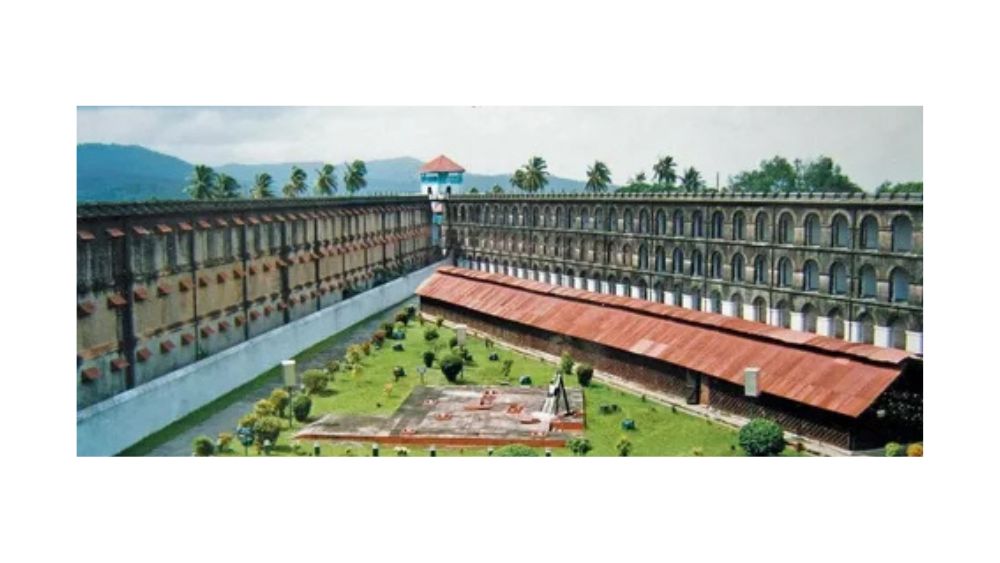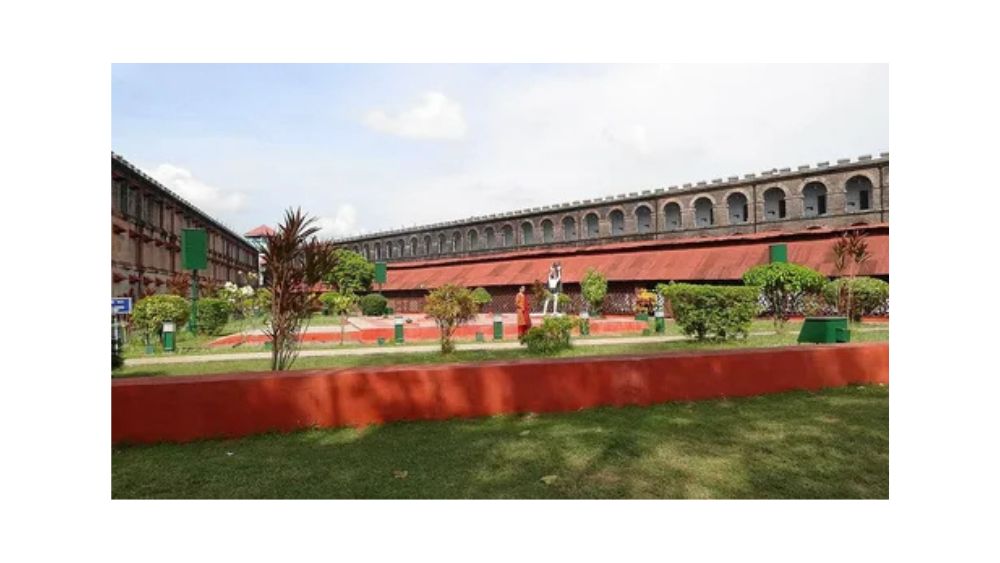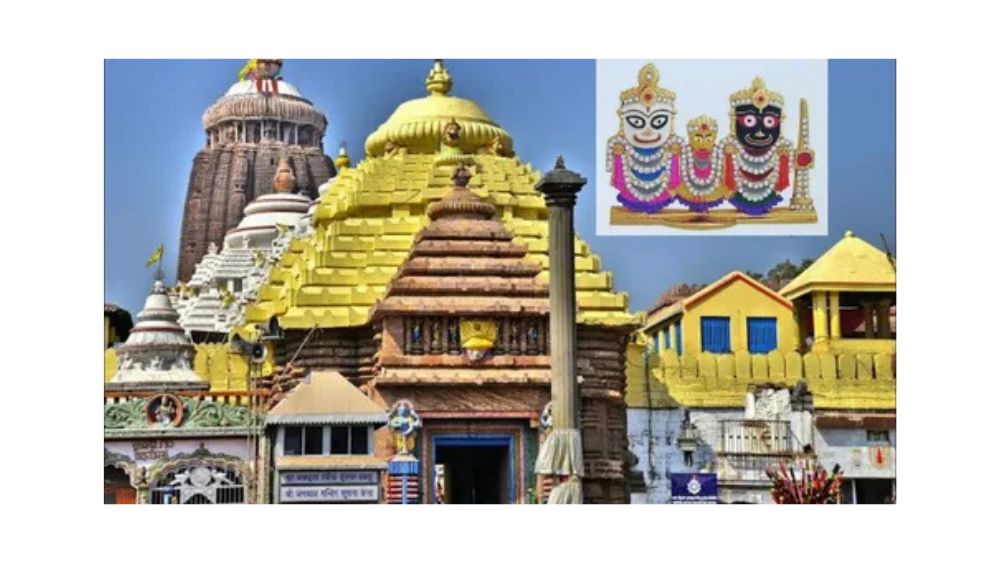The Most Beautiful Temples in Andaman and Nicobar | Complete Guide
Table of Contents
Introduction
Top 3 Temples in Andaman and Nicobar, a beautiful archipelago located in the Bay of Bengal, are known for their pristine beaches, rich culture, and unique history. While most tourists come for the stunning landscapes and water sports, the region is also home to some incredible temples that offer a glimpse into the spiritual heritage of the islands. These temples are not only significant for their religious importance but also hold a rich cultural history that connects the local people to their traditions and beliefs.
1. The Cellular Jail (Kala Pani) and the Temple Inside

History of the Cellular Jail
The Cellular Jail, also known as Kala Pani, is one of the most significant historical landmarks in the Andaman and Nicobar Islands. Built by the British colonial rulers in the late 19th century, it was designed as a high-security prison to house political prisoners and freedom fighters during India’s struggle for independence. The harsh conditions, isolation, and torture faced by the prisoners in this notorious jail made it a symbol of the sacrifices and suffering endured by those who fought for India’s freedom.
While the Cellular Jail is not a traditional religious temple, it does house a small shrine dedicated to Lord Shiva within its premises. The temple was constructed by the prisoners as a means of maintaining their spiritual strength and mental resilience in the face of their dire circumstances. The presence of this temple is a testament to the prisoners’ determination to hold onto their faith and traditions despite the brutal conditions they faced. Today, the temple continues to serve as a spiritual symbol, reminding visitors of the courage and endurance of those who suffered and perished within the jail’s walls.
Location
The Cellular Jail is located in Port Blair, the capital of the Andaman and Nicobar Islands. It is situated approximately 2 kilometers from the main harbor of Port Blair, making it easily accessible by a short drive. Due to its central location in the city, visitors can easily combine a trip to the Cellular Jail with other local attractions, including nearby beaches and markets.
Best Time to Visit

The best time to visit the Cellular Jail, including the temple inside, is during the cooler months, specifically from October to March. During this period, the weather in the Andaman and Nicobar Islands is pleasant, with lower humidity and comfortable temperatures, making it ideal for sightseeing and exploration.
It is recommended to avoid visiting during the monsoon season (from June to September), as the islands experience heavy rains that may disrupt travel plans and affect outdoor activities.
Features and Why You Should Visit
- Historical Significance: The Cellular Jail holds immense historical importance, especially for those interested in India’s colonial history and the struggle for independence. The prison was once home to some of India’s most prominent freedom fighters, including Veer Savarkar and Batukeshwar Dutt, who endured immense hardship during their imprisonment. The site serves as a powerful reminder of the sacrifices made by these brave individuals in their fight for India’s independence.
- Spiritual Reflection: The Shiva temple inside the Cellular Jail offers visitors a tranquil space to reflect on the past. Despite the harsh environment in which it was built, the temple stands as a symbol of the prisoners’ enduring faith and resilience. Today, visitors can visit the shrine to pay respects and find solace, making it a unique and peaceful spot within this historical site.
- Light and Sound Show: One of the highlights of visiting the Cellular Jail is the Light and Sound Show held in the evening. This show brings the history of the prison to life through vivid visuals, narration, and sound effects, recounting the story of the suffering of prisoners and the dark history of British colonial rule. The emotional and immersive experience of this show adds depth to the visit, making it more than just a historical tour but also a moment of reflection and remembrance.
2. The Jagannath Temple, Port Blair

History of the Jagannath Temple
The Jagannath Temple in Port Blair, located in the Andaman and Nicobar Islands, is dedicated to Lord Jagannath, a revered form of Lord Vishnu. This temple, built in 1993, was constructed by the local community to honor the rich religious traditions of Odisha, specifically the famous Jagannath Temple in Puri, Odisha. For many people from Odisha and other parts of India, the temple in Port Blair holds significant cultural and spiritual value, as it connects them to their roots and serves as a symbol of their heritage.
What makes this temple particularly unique is its annual Rath Yatra festival, which attracts both locals and tourists. During this vibrant event, the idol of Lord Jagannath, along with his siblings Balabhadra and Subhadra, are taken out in grand processions on large chariots. The festival is an exciting and colorful celebration that showcases the deep religious and cultural traditions of the temple, making it a major attraction for visitors to the Andaman and Nicobar Islands.
Location
The Jagannath Temple is conveniently located in Port Blair, the capital city of the Andaman and Nicobar Islands. It is situated approximately 7 kilometers from the main harbor of Port Blair, which makes it easily accessible by a short drive. Due to its central location, visitors can easily combine a visit to this temple with other nearby attractions, making it a convenient stop during their stay in the city.
Best Time to Visit

The best time to visit the Jagannath Temple is from October to March, as the weather during this period is cooler and more pleasant. These months are ideal for sightseeing and exploring the city, including visits to various cultural and historical landmarks like the Jagannath Temple.
However, if you want to witness the Rath Yatra festival, the best time to visit would be in June or July. The festival, one of the temple’s most significant events, involves grand processions, music, dance, and vibrant celebrations. It’s a fantastic time to experience the energy, joy, and cultural vibrancy that the temple brings to the local community.
Features and Why You Should Visit
- Religious Significance: The Jagannath Temple is an important place of worship, especially for Hindus from Odisha, as it follows the same religious traditions and rituals as the original temple in Puri. The temple is a symbol of faith for devotees who worship Lord Jagannath and his siblings, Balabhadra and Subhadra. For visitors, it offers an opportunity to learn about the religious practices followed by the local community and experience a connection to the rich cultural history of Odisha.
- Rath Yatra Festival: One of the main reasons to visit this temple is to witness the grand Rath Yatra festival. The procession, which involves the idols of Lord Jagannath, Balabhadra, and Subhadra being paraded through the streets on massive chariots, is a breathtaking sight. The event is filled with chanting, music, dance, and vibrant colors, creating an exciting and festive atmosphere. If you’re lucky enough to visit during the festival, it’s an experience you won’t want to miss.
- Architectural Beauty: The temple’s architecture is inspired by the traditional Odisha temple style, featuring intricately carved wooden doors, a tall spire, and a distinctive design that mimics the famous Puri Jagannath Temple. The temple’s beautiful construction and peaceful surroundings make it not only a place of worship but also a lovely spot to visit for anyone interested in architecture and art.
3. The Murugan Temple, Mayabunder

History of the Murugan Temple
The Murugan Temple located in Mayabunder, on the northern tip of the Andaman Islands, is a significant spiritual site and an important cultural landmark for the Tamil-speaking population living in the region. This temple is dedicated to Lord Murugan, the Hindu god of war, who is widely worshipped in Tamil culture and is considered the protector of good and the destroyer of evil. Lord Murugan, also known as Karthikeya, is often depicted as a warrior god riding a peacock and holding a spear. The temple was built to cater to the religious and spiritual needs of the Tamil community who had settled in the Andaman Islands, particularly during the 19th and early 20th centuries.
The Murugan Temple is famous for its annual Kavadi Attam festival, which is performed during the Thai Pongal festival (typically celebrated in January). Kavadi Attam is a traditional Tamil dance ritual in which devotees carry decorated wooden structures called kavadi on their shoulders as a form of penance and devotion to Lord Murugan. This festival is one of the most culturally significant events for the local Tamil community and draws many visitors from both within and outside the islands to witness the vibrant celebrations.
The temple is not just a place of worship, but also a symbol of the fusion of Tamil and local traditions, reflecting the diversity of religious practices in the Andaman and Nicobar Islands. The temple plays a key role in connecting the island’s Tamil population with their roots in South India, and it continues to be an important place for both spiritual reflection and cultural expression.
Location
The Murugan Temple is located in Mayabunder, a small town situated in the northern part of the Andaman Islands, approximately 50 kilometers from the capital city, Port Blair. Reaching Mayabunder involves a scenic road trip that offers beautiful views of the lush greenery and coastal landscapes that characterize this part of the islands. Visitors can reach the temple by road, with regular transportation available from Port Blair to Mayabunder. The journey to the temple allows travelers to experience the serene beauty of the Andaman Islands’ lesser-explored northern region, which is quieter and more remote compared to the bustling capital city.
Best Time to Visit
The best time to visit the Murugan Temple is during the cooler months, from October to March, when the weather is more comfortable and ideal for outdoor travel. During this period, the temperatures are pleasant, and the humidity is low, making it easier to explore the area and visit the temple without discomfort.
However, if you wish to experience the temple at its most vibrant, the Thai Pongal festival, which typically takes place in January, is the best time to visit. This is when the Kavadi Attam festival is held, and the temple is alive with color, music, and devotion. The festival is a significant cultural event for the Tamil community, and witnessing the rituals, performances, and processions during this time provides a truly unique and unforgettable experience.
Features and Why You Should Visit

- Cultural Experience: One of the main reasons to visit the Murugan Temple is to experience the rich and unique Tamil culture that thrives in the Andaman Islands. The Tamil population, many of whom are descendants of early settlers, has maintained strong ties to their roots in South India. At the Murugan Temple, visitors can learn about Tamil customs, rituals, and religious practices, which blend indigenous island traditions with South Indian influences. This cultural fusion is evident in the architecture, the worship practices, and the celebrations held at the temple.
- Peaceful Environment: The temple’s location in Mayabunder, surrounded by the calm and serene landscapes of the northern Andaman Islands, offers a peaceful retreat for spiritual reflection and prayer. Unlike the more tourist-heavy areas of the islands, Mayabunder is quieter, allowing visitors to experience a sense of tranquility. The surrounding natural beauty — with its forests, rivers, and beaches — enhances the temple’s peaceful atmosphere, making it an ideal place for anyone looking to find inner peace or simply connect with nature while exploring the spiritual aspects of the island.
- Kavadi Attam: The Kavadi Attam festival, which is the highlight of the Thai Pongal celebrations, is an extraordinary cultural experience that visitors should not miss. During the festival, devotees perform the traditional dance of Kavadi Attam, where they carry ornate wooden structures, or kavadi, as an act of devotion to Lord Murugan. The ritual is both physically demanding and spiritually significant, as devotees believe it is a way of showing gratitude and asking for blessings. The rhythmic drumming, chanting, and the colorful procession of devotees carrying kavadi in various shapes and sizes create a mesmerizing and lively atmosphere. Watching this vibrant display of faith and culture is a once-in-a-lifetime opportunity to witness Tamil religious traditions in their most authentic form.
Tips for Visiting Temples in Andaman and Nicobar Islands
- Respect the Local Customs: When visiting these temples, be sure to dress modestly and follow local customs, such as removing your shoes before entering.
- Plan Ahead: Since some temples, especially in remote areas like Mayabunder, may not have easy access to transportation, it’s best to plan your journey in advance.
- Explore Local Cuisine: After visiting the temples, take the opportunity to savor local dishes such as seafood and coconut-based delicacies, which are popular in the islands.
Conclusion
The Andaman and Nicobar Islands are not just about sun-kissed beaches and crystal-clear waters; they are also home to a rich spiritual heritage that dates back centuries. The Cellular Jail, Jagannath Temple, and Murugan Temple are just a few examples of the diverse temples in the region that offer peace, reflection, and a glimpse into the traditions that have shaped the islands’ history.
Whether you are a spiritual seeker, a history enthusiast, or a tourist wanting to experience the culture and heritage of the islands, these temples provide a unique perspective on the Andaman and Nicobar Islands’ rich tapestry of faith, culture, and history.
Frequently Asked Questions
1. What is the best time to visit the Andaman and Nicobar Islands for temple tourism?
The best time to visit the Andaman and Nicobar Islands for temple tourism is between October and March. During this period, the weather is cooler and more comfortable for sightseeing, with lower humidity and pleasant temperatures. The monsoon season (June to September) should be avoided due to heavy rains.
2. Are there any temples in the Andaman and Nicobar Islands related to Lord Shiva?
Yes, the Cellular Jail (Kala Pani) in Port Blair houses a small shrine dedicated to Lord Shiva. This shrine was built by the political prisoners during the British colonial period as a symbol of faith and resilience, making it a unique and spiritual place to visit within the historical site.
3. What is the significance of the Jagannath Temple in Port Blair?
The Jagannath Temple in Port Blair is dedicated to Lord Jagannath, a form of Lord Vishnu. Built in 1993, it follows the religious traditions of the famous Jagannath Temple in Puri, Odisha. The temple is especially popular for its Rath Yatra festival, where large processions of Lord Jagannath, Balabhadra, and Subhadra are paraded through the streets. It holds cultural and spiritual importance for the Odia community.
4. What is the Kavadi Attam festival at the Murugan Temple in Mayabunder?
The Kavadi Attam festival is a significant Tamil cultural event held at the Murugan Temple in Mayabunder. It is part of the Thai Pongal festival, where devotees carry decorated wooden structures called kavadi as a form of penance and devotion to Lord Murugan. The festival features vibrant processions, traditional dances, and religious rituals, making it a unique cultural experience for visitors.
5. What are the best ways to reach the temples in the Andaman and Nicobar Islands?
Most temples are located in Port Blair, the capital city, and are easily accessible by road. The Cellular Jail and Jagannath Temple are located within the city and can be reached by a short drive from the harbor. For more remote temples like the Murugan Temple in Mayabunder, visitors can take a scenic road trip, approximately 50 kilometers from Port Blair. Local transport options such as buses, taxis, and rented vehicles are available.
6. Are there any entry fees to visit the temples in the Andaman and Nicobar Islands?
Generally, entry to most temples is free. However, the Cellular Jail does have an entry fee, which includes access to the historical site and the light-and-sound show. Visitors may also need to pay for any special events or festivals, such as the Rath Yatra at the Jagannath Temple.
7. Can I visit these temples during religious festivals?
Yes, visiting these temples during festivals provides a unique and vibrant experience. For example, the Rath Yatra festival at the Jagannath Temple and the Kavadi Attam festival at the Murugan Temple are major events. If you want to experience these festivals, plan your visit during the respective festival months (June-July for Rath Yatra and January for Kavadi Attam).
8. What should I wear when visiting temples in the Andaman and Nicobar Islands?
When visiting temples, it is customary to wear modest and respectful clothing. For both men and women, covering the shoulders and legs is important. Additionally, you are usually required to remove your shoes before entering the temple premises.
9. Are these temples open to tourists or only locals?
These temples are open to both locals and tourists. Visitors from all over the world are welcome to explore the spiritual and cultural aspects of the temples. However, it is important to respect local customs and practices when visiting these sacred sites.
10. What can I expect to experience at the Cellular Jail Light and Sound Show?
The Light and Sound Show at the Cellular Jail is a moving and immersive experience that recounts the history of the prison and the sacrifices of the freedom fighters who were imprisoned there. Using vivid visuals, narration, and sound effects, the show highlights the brutality of British colonial rule, the suffering of prisoners, and the ultimate victory of India’s independence.
By – travelloguide

